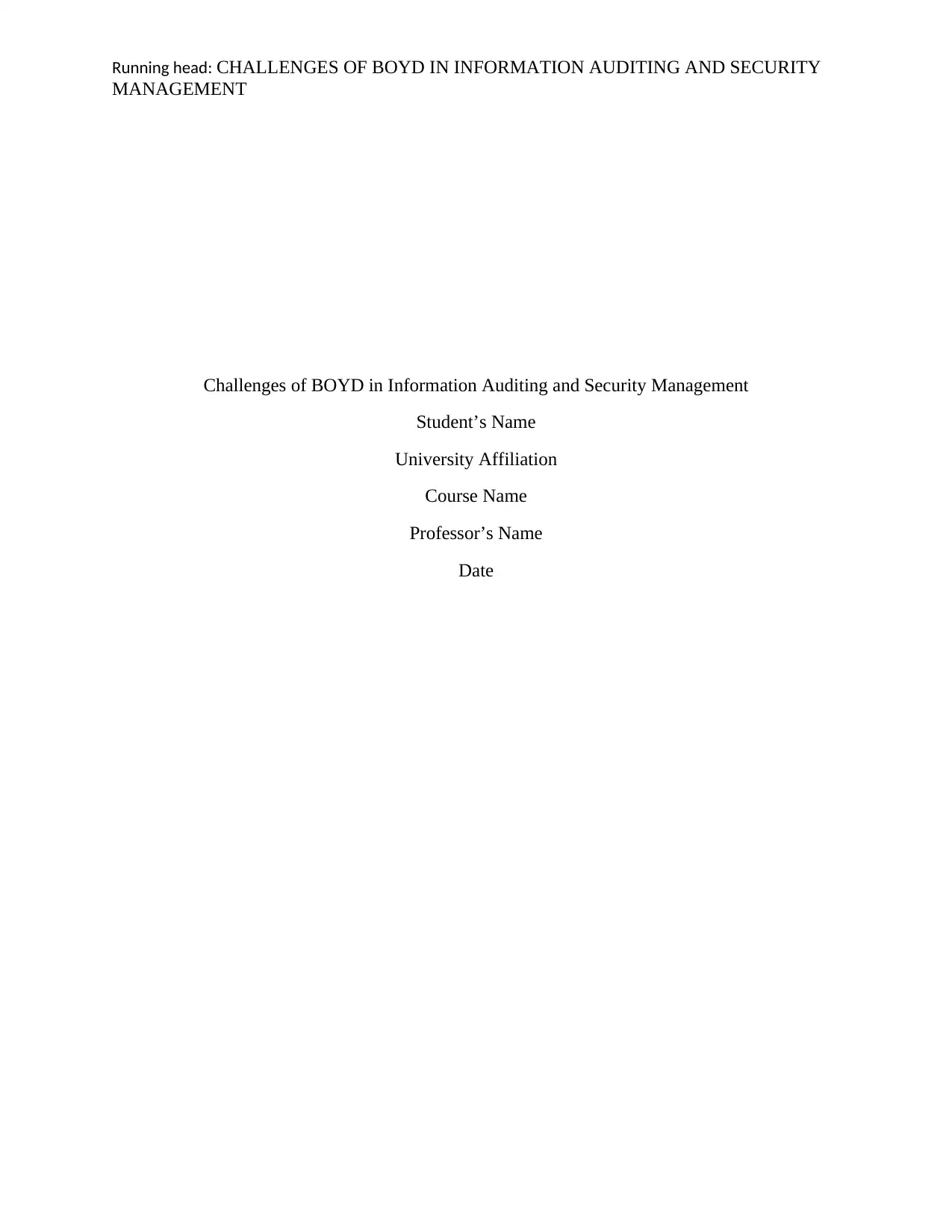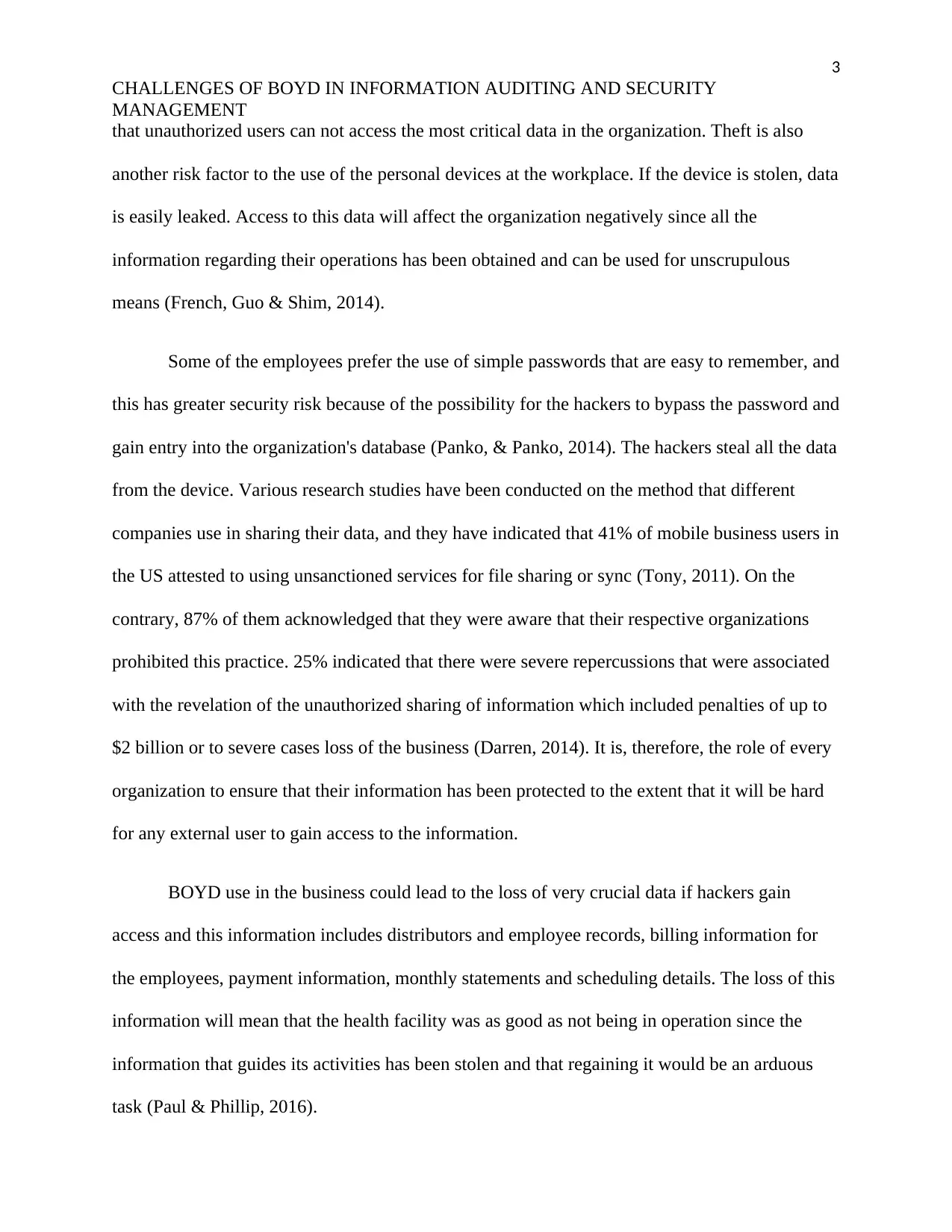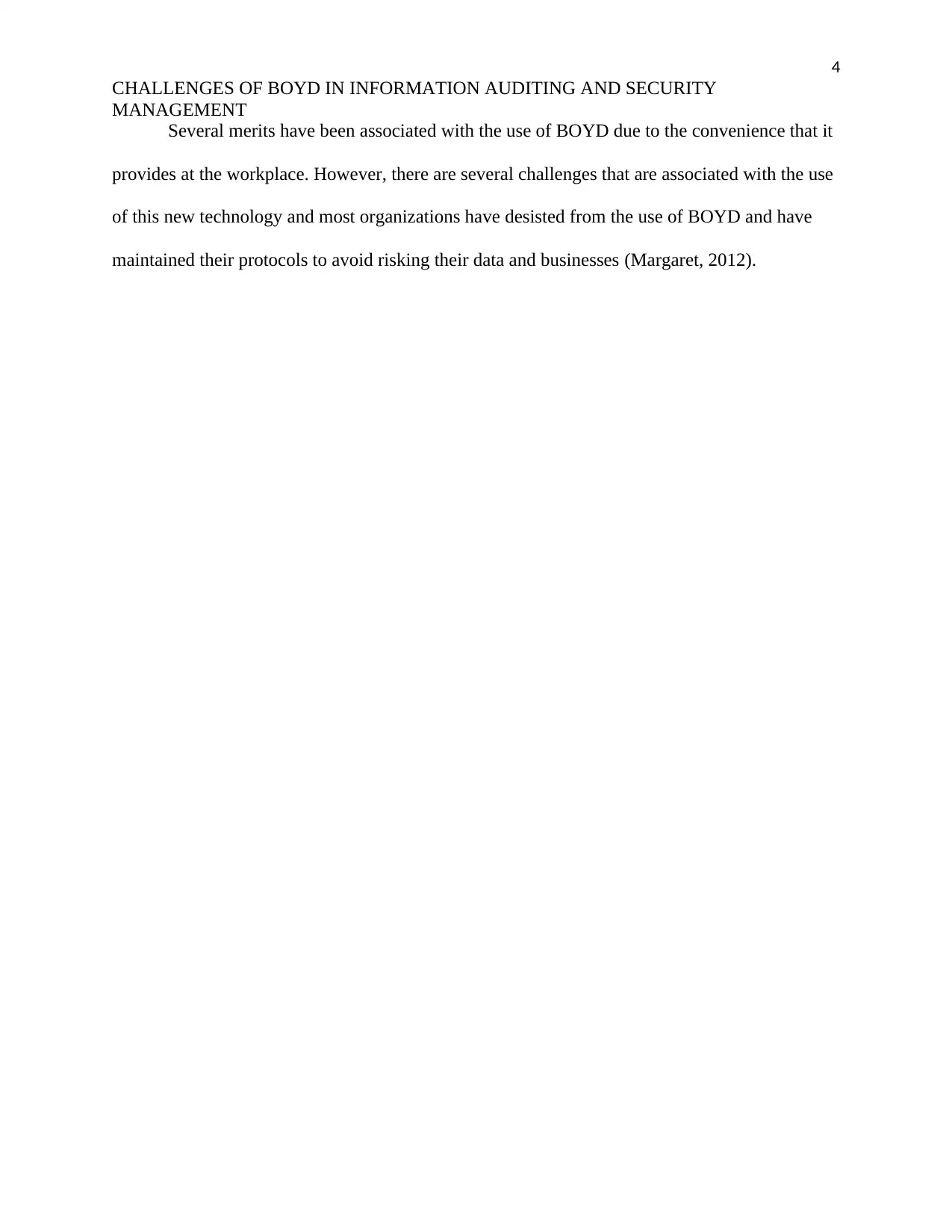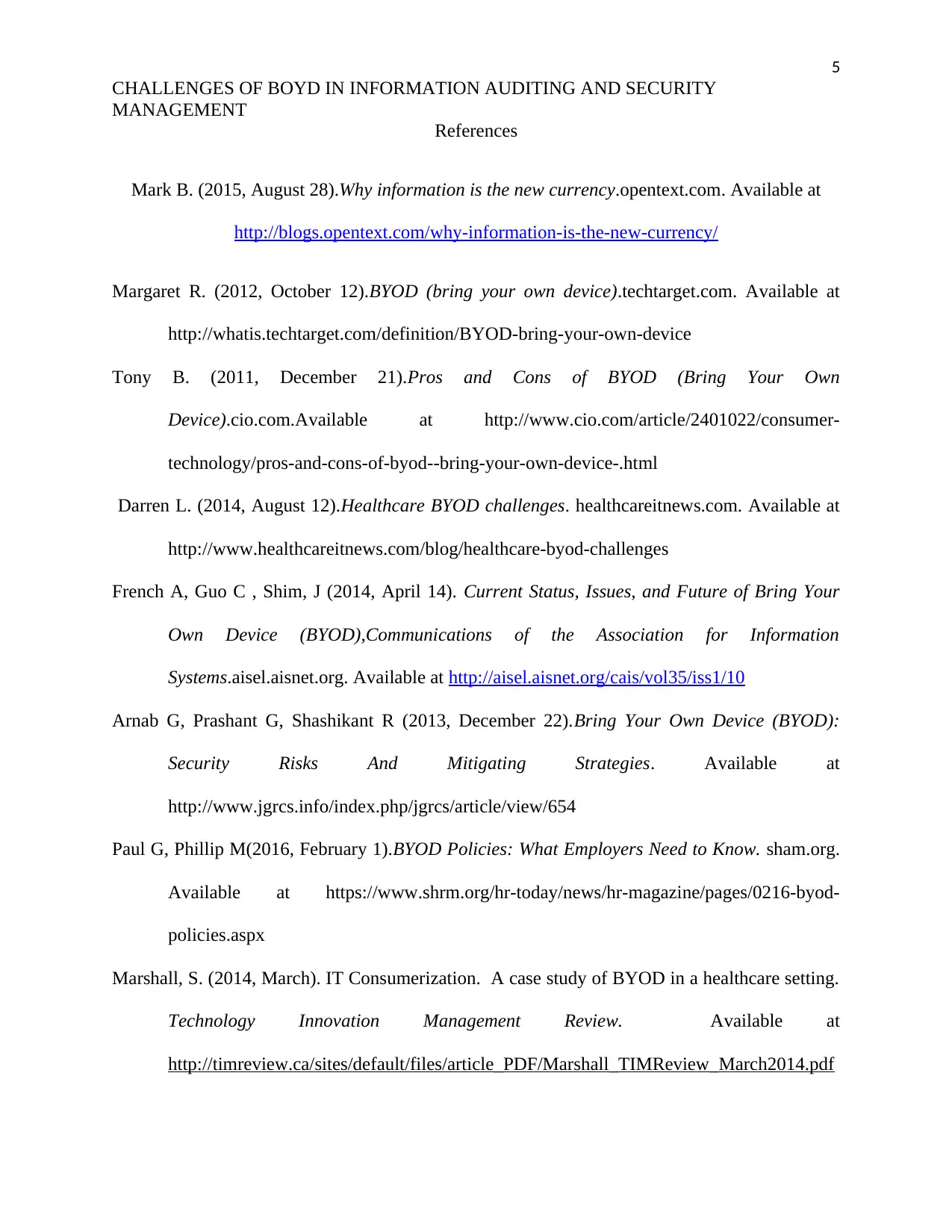Challenges of BOYD in Information Auditing and Security Management
VerifiedAdded on 2020/03/01
|6
|1119
|32
Report
AI Summary
This report delves into the multifaceted challenges of implementing Bring Your Own Device (BYOD) policies within organizations, focusing on information auditing and security management. It highlights the convenience of BYOD, such as improved employee efficiency and reduced hardware costs, while critically examining the associated risks. These risks include potential data loss due to insecure networks, theft of devices leading to data breaches, and the use of weak passwords. The report emphasizes the importance of robust security measures, such as VPNs and strong password protocols, to protect sensitive data. It references various research studies and statistics to underscore the severity of these challenges, including employee behaviors and the financial repercussions of data breaches. The report concludes by stressing the need for organizations to prioritize data protection and maintain strong security protocols to mitigate the inherent risks of BYOD.

Running head: CHALLENGES OF BOYD IN INFORMATION AUDITING AND SECURITY
MANAGEMENT
Challenges of BOYD in Information Auditing and Security Management
Student’s Name
University Affiliation
Course Name
Professor’s Name
Date
MANAGEMENT
Challenges of BOYD in Information Auditing and Security Management
Student’s Name
University Affiliation
Course Name
Professor’s Name
Date
Paraphrase This Document
Need a fresh take? Get an instant paraphrase of this document with our AI Paraphraser

2
CHALLENGES OF BOYD IN INFORMATION AUDITING AND SECURITY
MANAGEMENT
Challenges of BOYD in Information Auditing and Information Security Management
Bring Your Own Device is a situation where the employees of a company are allowed by
the management to carry their laptops and phones to the workplace. By allowing the employees
to take their own devices, the efficiency at the workplace is improved since each employee will
be using their device and there will be no sharing and improves networking between the workers
and clients (Mark, 2015). All these benefits are brought about by the ease access to their emails,
customer contacts, work files and access to internet services at any place and time. There is also
the merit of cost reduction in that the quantity of hardware that the company is required to
purchase will significantly reduce and the amount will be allocated to other uses. The facility
also creates potential attraction to the service and most especially to the employees who enjoy
using personal devices. There are several limitations involved with these devices and are
discussed in the subsequent section.
Use of BOYD at institutions has the potential to raise severe issues that will have an
adverse impact on the establishment regardless of the convenience they create to the employees.
Loss of very vital data is possible since every individual has access to the database and thus not
likely to hold any person accountable for the data loss. According to the second chapter of the
Fundamentals of Information Systems Security, the greatest risk to information is when the
devices that are being used by the employees will connect to a network that is not secure for
internet services. This risk is brought about by the lack of passwords in public which will leads
to display of all the information in the text. In most corporate organizations, the use of a VPN is
very typical because it ensures all data is secure and unauthorized access is not possible (Arnab,
Prashant & Shashikant, 2013). Recently, there has been advancement in data security, and there
are virtual networks that will require a password to access data. These security measures ensure
CHALLENGES OF BOYD IN INFORMATION AUDITING AND SECURITY
MANAGEMENT
Challenges of BOYD in Information Auditing and Information Security Management
Bring Your Own Device is a situation where the employees of a company are allowed by
the management to carry their laptops and phones to the workplace. By allowing the employees
to take their own devices, the efficiency at the workplace is improved since each employee will
be using their device and there will be no sharing and improves networking between the workers
and clients (Mark, 2015). All these benefits are brought about by the ease access to their emails,
customer contacts, work files and access to internet services at any place and time. There is also
the merit of cost reduction in that the quantity of hardware that the company is required to
purchase will significantly reduce and the amount will be allocated to other uses. The facility
also creates potential attraction to the service and most especially to the employees who enjoy
using personal devices. There are several limitations involved with these devices and are
discussed in the subsequent section.
Use of BOYD at institutions has the potential to raise severe issues that will have an
adverse impact on the establishment regardless of the convenience they create to the employees.
Loss of very vital data is possible since every individual has access to the database and thus not
likely to hold any person accountable for the data loss. According to the second chapter of the
Fundamentals of Information Systems Security, the greatest risk to information is when the
devices that are being used by the employees will connect to a network that is not secure for
internet services. This risk is brought about by the lack of passwords in public which will leads
to display of all the information in the text. In most corporate organizations, the use of a VPN is
very typical because it ensures all data is secure and unauthorized access is not possible (Arnab,
Prashant & Shashikant, 2013). Recently, there has been advancement in data security, and there
are virtual networks that will require a password to access data. These security measures ensure

3
CHALLENGES OF BOYD IN INFORMATION AUDITING AND SECURITY
MANAGEMENT
that unauthorized users can not access the most critical data in the organization. Theft is also
another risk factor to the use of the personal devices at the workplace. If the device is stolen, data
is easily leaked. Access to this data will affect the organization negatively since all the
information regarding their operations has been obtained and can be used for unscrupulous
means (French, Guo & Shim, 2014).
Some of the employees prefer the use of simple passwords that are easy to remember, and
this has greater security risk because of the possibility for the hackers to bypass the password and
gain entry into the organization's database (Panko, & Panko, 2014). The hackers steal all the data
from the device. Various research studies have been conducted on the method that different
companies use in sharing their data, and they have indicated that 41% of mobile business users in
the US attested to using unsanctioned services for file sharing or sync (Tony, 2011). On the
contrary, 87% of them acknowledged that they were aware that their respective organizations
prohibited this practice. 25% indicated that there were severe repercussions that were associated
with the revelation of the unauthorized sharing of information which included penalties of up to
$2 billion or to severe cases loss of the business (Darren, 2014). It is, therefore, the role of every
organization to ensure that their information has been protected to the extent that it will be hard
for any external user to gain access to the information.
BOYD use in the business could lead to the loss of very crucial data if hackers gain
access and this information includes distributors and employee records, billing information for
the employees, payment information, monthly statements and scheduling details. The loss of this
information will mean that the health facility was as good as not being in operation since the
information that guides its activities has been stolen and that regaining it would be an arduous
task (Paul & Phillip, 2016).
CHALLENGES OF BOYD IN INFORMATION AUDITING AND SECURITY
MANAGEMENT
that unauthorized users can not access the most critical data in the organization. Theft is also
another risk factor to the use of the personal devices at the workplace. If the device is stolen, data
is easily leaked. Access to this data will affect the organization negatively since all the
information regarding their operations has been obtained and can be used for unscrupulous
means (French, Guo & Shim, 2014).
Some of the employees prefer the use of simple passwords that are easy to remember, and
this has greater security risk because of the possibility for the hackers to bypass the password and
gain entry into the organization's database (Panko, & Panko, 2014). The hackers steal all the data
from the device. Various research studies have been conducted on the method that different
companies use in sharing their data, and they have indicated that 41% of mobile business users in
the US attested to using unsanctioned services for file sharing or sync (Tony, 2011). On the
contrary, 87% of them acknowledged that they were aware that their respective organizations
prohibited this practice. 25% indicated that there were severe repercussions that were associated
with the revelation of the unauthorized sharing of information which included penalties of up to
$2 billion or to severe cases loss of the business (Darren, 2014). It is, therefore, the role of every
organization to ensure that their information has been protected to the extent that it will be hard
for any external user to gain access to the information.
BOYD use in the business could lead to the loss of very crucial data if hackers gain
access and this information includes distributors and employee records, billing information for
the employees, payment information, monthly statements and scheduling details. The loss of this
information will mean that the health facility was as good as not being in operation since the
information that guides its activities has been stolen and that regaining it would be an arduous
task (Paul & Phillip, 2016).
⊘ This is a preview!⊘
Do you want full access?
Subscribe today to unlock all pages.

Trusted by 1+ million students worldwide

4
CHALLENGES OF BOYD IN INFORMATION AUDITING AND SECURITY
MANAGEMENT
Several merits have been associated with the use of BOYD due to the convenience that it
provides at the workplace. However, there are several challenges that are associated with the use
of this new technology and most organizations have desisted from the use of BOYD and have
maintained their protocols to avoid risking their data and businesses (Margaret, 2012).
CHALLENGES OF BOYD IN INFORMATION AUDITING AND SECURITY
MANAGEMENT
Several merits have been associated with the use of BOYD due to the convenience that it
provides at the workplace. However, there are several challenges that are associated with the use
of this new technology and most organizations have desisted from the use of BOYD and have
maintained their protocols to avoid risking their data and businesses (Margaret, 2012).
Paraphrase This Document
Need a fresh take? Get an instant paraphrase of this document with our AI Paraphraser

5
CHALLENGES OF BOYD IN INFORMATION AUDITING AND SECURITY
MANAGEMENT
References
Mark B. (2015, August 28).Why information is the new currency.opentext.com. Available at
http://blogs.opentext.com/why-information-is-the-new-currency/
Margaret R. (2012, October 12).BYOD (bring your own device).techtarget.com. Available at
http://whatis.techtarget.com/definition/BYOD-bring-your-own-device
Tony B. (2011, December 21).Pros and Cons of BYOD (Bring Your Own
Device).cio.com.Available at http://www.cio.com/article/2401022/consumer-
technology/pros-and-cons-of-byod--bring-your-own-device-.html
Darren L. (2014, August 12).Healthcare BYOD challenges. healthcareitnews.com. Available at
http://www.healthcareitnews.com/blog/healthcare-byod-challenges
French A, Guo C , Shim, J (2014, April 14). Current Status, Issues, and Future of Bring Your
Own Device (BYOD),Communications of the Association for Information
Systems.aisel.aisnet.org. Available at http://aisel.aisnet.org/cais/vol35/iss1/10
Arnab G, Prashant G, Shashikant R (2013, December 22).Bring Your Own Device (BYOD):
Security Risks And Mitigating Strategies. Available at
http://www.jgrcs.info/index.php/jgrcs/article/view/654
Paul G, Phillip M(2016, February 1).BYOD Policies: What Employers Need to Know. sham.org.
Available at https://www.shrm.org/hr-today/news/hr-magazine/pages/0216-byod-
policies.aspx
Marshall, S. (2014, March). IT Consumerization. A case study of BYOD in a healthcare setting.
Technology Innovation Management Review. Available at
http://timreview.ca/sites/default/files/article_PDF/Marshall_TIMReview_March2014.pdf
CHALLENGES OF BOYD IN INFORMATION AUDITING AND SECURITY
MANAGEMENT
References
Mark B. (2015, August 28).Why information is the new currency.opentext.com. Available at
http://blogs.opentext.com/why-information-is-the-new-currency/
Margaret R. (2012, October 12).BYOD (bring your own device).techtarget.com. Available at
http://whatis.techtarget.com/definition/BYOD-bring-your-own-device
Tony B. (2011, December 21).Pros and Cons of BYOD (Bring Your Own
Device).cio.com.Available at http://www.cio.com/article/2401022/consumer-
technology/pros-and-cons-of-byod--bring-your-own-device-.html
Darren L. (2014, August 12).Healthcare BYOD challenges. healthcareitnews.com. Available at
http://www.healthcareitnews.com/blog/healthcare-byod-challenges
French A, Guo C , Shim, J (2014, April 14). Current Status, Issues, and Future of Bring Your
Own Device (BYOD),Communications of the Association for Information
Systems.aisel.aisnet.org. Available at http://aisel.aisnet.org/cais/vol35/iss1/10
Arnab G, Prashant G, Shashikant R (2013, December 22).Bring Your Own Device (BYOD):
Security Risks And Mitigating Strategies. Available at
http://www.jgrcs.info/index.php/jgrcs/article/view/654
Paul G, Phillip M(2016, February 1).BYOD Policies: What Employers Need to Know. sham.org.
Available at https://www.shrm.org/hr-today/news/hr-magazine/pages/0216-byod-
policies.aspx
Marshall, S. (2014, March). IT Consumerization. A case study of BYOD in a healthcare setting.
Technology Innovation Management Review. Available at
http://timreview.ca/sites/default/files/article_PDF/Marshall_TIMReview_March2014.pdf

6
CHALLENGES OF BOYD IN INFORMATION AUDITING AND SECURITY
MANAGEMENT
Panko, R., & Panko, J. (2014). Business data networks and security. (10th ed.). New York:
Prentice Hall. ISBN-13: 978-0133544015
CHALLENGES OF BOYD IN INFORMATION AUDITING AND SECURITY
MANAGEMENT
Panko, R., & Panko, J. (2014). Business data networks and security. (10th ed.). New York:
Prentice Hall. ISBN-13: 978-0133544015
⊘ This is a preview!⊘
Do you want full access?
Subscribe today to unlock all pages.

Trusted by 1+ million students worldwide
1 out of 6
Related Documents
Your All-in-One AI-Powered Toolkit for Academic Success.
+13062052269
info@desklib.com
Available 24*7 on WhatsApp / Email
![[object Object]](/_next/static/media/star-bottom.7253800d.svg)
Unlock your academic potential
Copyright © 2020–2025 A2Z Services. All Rights Reserved. Developed and managed by ZUCOL.





